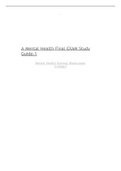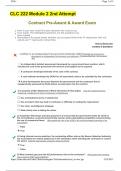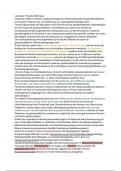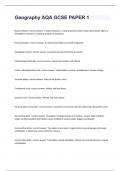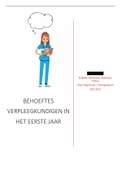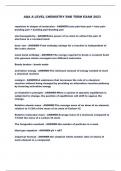Lecture notes Applied Molecular
Microbiology
Central dogma and applications
Central dogma: DNA -> RNA -> protein. This is the recipe for all
living organisms. All processes in the central dogma are
reversible, this is shown in the bottom of the image.
DNA degradation occurs using nucleases, RNA processing
occurs using ribonucleases and protein processing uses
proteases.
RNA has a different sugar molecule in the strand, namely ribose. DNA has a deoxyribose molecule.
The first carbon in the sugar molecule attaches the base, the second carbon determines if it is a
deoxyribose or a ribose molecule. The third carbon can attach the next nucleotide (3’-end) and the
fifth carbon attaches the three phosphate molecules (5’-end).
In DNA synthesis, upon dNTP binding, a
conformation change generates a tight pocket that
allows only correctly matching nucleotide bases.
Binding of a new nucleotide (three phosphate
molecules), causes a hydrolysis reaction, after which
pyrophosphate (PPi ) is released.
Chemical synthesis of DNA occurs in the 3’ to 5’
direction, which is opposite to the natural synthesis.
During chemical synthesis, a protective molecule
can be added to protect the 5’-end. Chemical DNA is
used for DNA primers and templates, often used in PCR reactions.
DNA sequence analysis is often performed using the Sanger method. In the Sanger method, the OH-
group in the 3’-end of the molecule is removed, so that the DNA chain cannot grow anymore. DNA
polymerization occurs. Once a Sanger molecule is incorporated, the chain stops growing. The result of
DNA polymerization will be a mix of fragments of different sizes, which can be analysed on a gel.
Nowadays, fluorescent Sanger nucleotides are used, that can tag the molecule for detection.
Pyrosequencing: another analysis method. This method is based on the release of PP i, since PPi can be
converted to an ATP molecule. ATP can react with luciferase, which leads to the formation of a beam
of light. This beam of light can be visualized. The light
intensity will be higher when more nucleotides are
incorporated.
Sigma factors can bind to the promotor sequence on DNA.
RNA polymerase can bind to the Sigma factors to initiate
transcription. RBS: ribosome binding sequence, which is a
sequence of nucleotides upstream of the start codon of an
mRNA transcript that is responsible for the recruitment of a
ribosome during the initiation of translation. The process of
translation is shown in the image.
Ribosomes have a very conserved structure.
, Codon bias
Genetic code: a triplet of nucleotides (codon) codes for an amino acid. tRNAs with a specific
anticodon delver specific amino acids.
A ribosome consists of a large and a small subunit. The small subunit can hold the tRNA in the
correct place, the large subunit binds the small subunit. Energy is delivered via GTP, which
drives the movement of one codon to
the next codon.
P-site: attaches the growing peptide
chain. A-site: where the amino acid
comes in.
Secondary structure of mRNA:
consists of structures within the
mRNA molecule that tune translation.
An example are the hairpins, which
are folds of the mRNA. This can slow
down the translation by blocking the
ribosome. Secondary structures can
also make it difficult for the ribosome
to attach to the mRNA to initiate
translation.
The set of tRNAs is always
incomplete: there are more possible
codons than there are tRNAs. In E. coli, there are 39 tRNAs and 61 codons, in humans, there are 45
tRNAs and 61 codons. Despite missing some tRNAs, all codons can be translated, which is due to non-
Watson and Crick base pairing (wobble hypothesis). In RNA, base-pairing between G and U can occur
(not in DNA between G and T!), where two hydrogen bonds are formed. On the codon, the 3’-
position is less important for perfect binding (the same accounts for the 5’-position of the anticodon).
Some missing tRNAs cannot be converted by wobbling, they need tRNAs with modified anti-codon
nucleotides. An example is inosine, which can base pair with C, U, and A.
Amino-acyl-tRNA synthase makes sure that only one specific amino acid is added to a tRNA. This
addition determines the tRNA amino acid charging state. Good codons are translated faster and more
accurately. However, non-optimal codons are maintained during evolution, which indicates a
biological relevant function for the codon bias.
The codon bias can tune the translation, as non-optimal codons (especially the codons in the
beginning) slow down the translation process, to allow for co-translational folding of the nascent
polypeptide chain. The codon bias means that translation initiation does not only occur at 5’ end of
polycistronic messenger, but also at internal ribosome binding sites (RBSs). The codon bias differs per
person.
Codon harmonization: when you try to mimic the codon landscape from one organism into another
organism.
Protein overproduction
E. coli use for recombinant protein expression has several advantages and disadvantages.
Advantages:
Availability - commonly used in every molecular genetics laboratory
Feasibility - relatively simple genetic manipulation
Efficiency - easy, fast & cheap cultivation
, Disadvantages:
No post-translational modification (eukaryotic proteins)
Proteins may aggregate as “inclusion bodies”
Difficult to secrete large amounts of proteins to medium
If you want to overproduce proteins, you make use of a plasmid vector. Common
features:
A replicator (origin of replication). Shuttle vectors: contains two origins of
replication from two different organisms (can be used in both
organisms).
Suicide vectors: only works in one of the two organisms. The plasmid
does not survive in the host (no origin of replication).
High-copy number plasmid: control independent of chromosomal
replication.
Low-copy number plasmid: synchronized with cell division. An example is the toxin/anti-toxin
combination. This system can control cell death. The toxin CcdB is relatively stable, the anti-
toxin CcdA is relatively unstable.
A selectable marker. Dominant marker (for example antibiotic resistance -> ampR): only
growth of recombinant in the presence of antibiotic. Under certain conditions, it is critical to
have this marker for survival.
Recessive marker (for example amino acid biosynthesis enzyme -> leuB): only growth of
recombinant in the absence of amino acids.
A cloning site: where the gene of interest is put, often using restriction enzymes. In the past
10 years several cloning strategies have been developed, some of which are independent of
restriction enzymes (Gibson assembly).
Vectors can also have additional features:
Promotor, RBS: for regulation of transcription.
RBS: the sequence in the 5’-UTR that is being
recognized by the ribosome. The sequence (in
the image: under ‘SD’) of the RBS can base-pair
with the ribosomal RNA.
T7 promotor: often used for protein
overexpression in E.coli. If you put this promotor on the
vector of your gene of interest, you get very high
expressions of the protein (=strong promotor). The T7
promotor can only be used in E.coli strains that produce
the T7 RNA polymerase. The T7 promotor can regulate the
lac operon.
Fusion protein/peptide. Examples are the histidine tag (for
metal affinity chromatography), the GFP (usage as a
reporter) or the maltose-binding protein (may prevent
inclusion bodies).
Codon usage/codon bias: “good” codons result in more efficient translation elongation, “bad”
codons may still be a problem for heterologous expression. When 4 or more “bad” codons
occur next to each other, this may lead to “stalling” of the ribosome, and eventually to either
misfolding of the polypeptide chain (inclusion bodies), or abortion of translation and
Microbiology
Central dogma and applications
Central dogma: DNA -> RNA -> protein. This is the recipe for all
living organisms. All processes in the central dogma are
reversible, this is shown in the bottom of the image.
DNA degradation occurs using nucleases, RNA processing
occurs using ribonucleases and protein processing uses
proteases.
RNA has a different sugar molecule in the strand, namely ribose. DNA has a deoxyribose molecule.
The first carbon in the sugar molecule attaches the base, the second carbon determines if it is a
deoxyribose or a ribose molecule. The third carbon can attach the next nucleotide (3’-end) and the
fifth carbon attaches the three phosphate molecules (5’-end).
In DNA synthesis, upon dNTP binding, a
conformation change generates a tight pocket that
allows only correctly matching nucleotide bases.
Binding of a new nucleotide (three phosphate
molecules), causes a hydrolysis reaction, after which
pyrophosphate (PPi ) is released.
Chemical synthesis of DNA occurs in the 3’ to 5’
direction, which is opposite to the natural synthesis.
During chemical synthesis, a protective molecule
can be added to protect the 5’-end. Chemical DNA is
used for DNA primers and templates, often used in PCR reactions.
DNA sequence analysis is often performed using the Sanger method. In the Sanger method, the OH-
group in the 3’-end of the molecule is removed, so that the DNA chain cannot grow anymore. DNA
polymerization occurs. Once a Sanger molecule is incorporated, the chain stops growing. The result of
DNA polymerization will be a mix of fragments of different sizes, which can be analysed on a gel.
Nowadays, fluorescent Sanger nucleotides are used, that can tag the molecule for detection.
Pyrosequencing: another analysis method. This method is based on the release of PP i, since PPi can be
converted to an ATP molecule. ATP can react with luciferase, which leads to the formation of a beam
of light. This beam of light can be visualized. The light
intensity will be higher when more nucleotides are
incorporated.
Sigma factors can bind to the promotor sequence on DNA.
RNA polymerase can bind to the Sigma factors to initiate
transcription. RBS: ribosome binding sequence, which is a
sequence of nucleotides upstream of the start codon of an
mRNA transcript that is responsible for the recruitment of a
ribosome during the initiation of translation. The process of
translation is shown in the image.
Ribosomes have a very conserved structure.
, Codon bias
Genetic code: a triplet of nucleotides (codon) codes for an amino acid. tRNAs with a specific
anticodon delver specific amino acids.
A ribosome consists of a large and a small subunit. The small subunit can hold the tRNA in the
correct place, the large subunit binds the small subunit. Energy is delivered via GTP, which
drives the movement of one codon to
the next codon.
P-site: attaches the growing peptide
chain. A-site: where the amino acid
comes in.
Secondary structure of mRNA:
consists of structures within the
mRNA molecule that tune translation.
An example are the hairpins, which
are folds of the mRNA. This can slow
down the translation by blocking the
ribosome. Secondary structures can
also make it difficult for the ribosome
to attach to the mRNA to initiate
translation.
The set of tRNAs is always
incomplete: there are more possible
codons than there are tRNAs. In E. coli, there are 39 tRNAs and 61 codons, in humans, there are 45
tRNAs and 61 codons. Despite missing some tRNAs, all codons can be translated, which is due to non-
Watson and Crick base pairing (wobble hypothesis). In RNA, base-pairing between G and U can occur
(not in DNA between G and T!), where two hydrogen bonds are formed. On the codon, the 3’-
position is less important for perfect binding (the same accounts for the 5’-position of the anticodon).
Some missing tRNAs cannot be converted by wobbling, they need tRNAs with modified anti-codon
nucleotides. An example is inosine, which can base pair with C, U, and A.
Amino-acyl-tRNA synthase makes sure that only one specific amino acid is added to a tRNA. This
addition determines the tRNA amino acid charging state. Good codons are translated faster and more
accurately. However, non-optimal codons are maintained during evolution, which indicates a
biological relevant function for the codon bias.
The codon bias can tune the translation, as non-optimal codons (especially the codons in the
beginning) slow down the translation process, to allow for co-translational folding of the nascent
polypeptide chain. The codon bias means that translation initiation does not only occur at 5’ end of
polycistronic messenger, but also at internal ribosome binding sites (RBSs). The codon bias differs per
person.
Codon harmonization: when you try to mimic the codon landscape from one organism into another
organism.
Protein overproduction
E. coli use for recombinant protein expression has several advantages and disadvantages.
Advantages:
Availability - commonly used in every molecular genetics laboratory
Feasibility - relatively simple genetic manipulation
Efficiency - easy, fast & cheap cultivation
, Disadvantages:
No post-translational modification (eukaryotic proteins)
Proteins may aggregate as “inclusion bodies”
Difficult to secrete large amounts of proteins to medium
If you want to overproduce proteins, you make use of a plasmid vector. Common
features:
A replicator (origin of replication). Shuttle vectors: contains two origins of
replication from two different organisms (can be used in both
organisms).
Suicide vectors: only works in one of the two organisms. The plasmid
does not survive in the host (no origin of replication).
High-copy number plasmid: control independent of chromosomal
replication.
Low-copy number plasmid: synchronized with cell division. An example is the toxin/anti-toxin
combination. This system can control cell death. The toxin CcdB is relatively stable, the anti-
toxin CcdA is relatively unstable.
A selectable marker. Dominant marker (for example antibiotic resistance -> ampR): only
growth of recombinant in the presence of antibiotic. Under certain conditions, it is critical to
have this marker for survival.
Recessive marker (for example amino acid biosynthesis enzyme -> leuB): only growth of
recombinant in the absence of amino acids.
A cloning site: where the gene of interest is put, often using restriction enzymes. In the past
10 years several cloning strategies have been developed, some of which are independent of
restriction enzymes (Gibson assembly).
Vectors can also have additional features:
Promotor, RBS: for regulation of transcription.
RBS: the sequence in the 5’-UTR that is being
recognized by the ribosome. The sequence (in
the image: under ‘SD’) of the RBS can base-pair
with the ribosomal RNA.
T7 promotor: often used for protein
overexpression in E.coli. If you put this promotor on the
vector of your gene of interest, you get very high
expressions of the protein (=strong promotor). The T7
promotor can only be used in E.coli strains that produce
the T7 RNA polymerase. The T7 promotor can regulate the
lac operon.
Fusion protein/peptide. Examples are the histidine tag (for
metal affinity chromatography), the GFP (usage as a
reporter) or the maltose-binding protein (may prevent
inclusion bodies).
Codon usage/codon bias: “good” codons result in more efficient translation elongation, “bad”
codons may still be a problem for heterologous expression. When 4 or more “bad” codons
occur next to each other, this may lead to “stalling” of the ribosome, and eventually to either
misfolding of the polypeptide chain (inclusion bodies), or abortion of translation and


